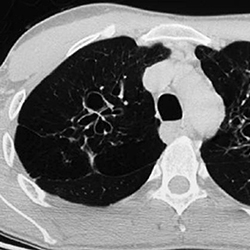By Landon Gray
There has been an increase in fungal infections associated with COVID-19 infection during the pandemic, the most common one being COVID-19–associated Aspergillus pneumonia (CAPA).

A research team reported the mortality rate of CAPA to be 56% on average. CAPA has been confirmed by autopsy studies, but commonality varies significantly by country and region, according to research presented at IDWeek 2022, held in Washington, D.C.
Depending on location, the researchers found CAPA rates can be anywhere from 0% to 39% (Open Forum Infect Dis 2021;8[12]:ofab510 https://doi.org/10.1093/ofid/ofab510). They documented European countries tend to report higher rates than other regions, most likely driven by differences in the availability and intensity of mycologic testing. Pooled incidence in 37 published studies found a 10% CAPA rate (95% CI, 91%-11.1%). And when limited to 31 studies with sufficient data to use the definitions established by the European Confederation of Medical Mycology and International Society for Human and Animal Mycology (ECMM/ISHAM), incidence dropped to 7.6% (95% CI, 6.6%-8.7%).
“I came into this as kind of a skeptic. I’ve come away as more of a believer,” said Peter G. Pappas, MD, FACP, a professor emeritus of medicine and the chair of the Mycoses Study Group Education and Research Consortium in the Division of Infectious Diseases at the University of Alabama at Birmingham, who served as a study researcher.
“If you look at 37 published studies, where you can actually extract the data, and according to European Organisation for Research and Treatment of Cancer definitions, about 10% meet definition. If you use the newly described ECMM/ISHAM definitions, the rate goes down to about 8%. But it’s still there,” he explained.
In one case study analyzed by the researchers, a 40-year-old woman with a history of connective tissue disease–associated interstitial lung disease with a subsequent bilateral lung transplant in July 2018 and stable immunosuppression with azathioprine, prednisone and tacrolimus presented with acute hypoxemic respiratory failure due to COVID-19.
The patient presented two days after being symptomatic and received remdesivir (Veklury, Gilead) for five days, two doses of convalescent plasma, 10 days of dexamethasone, and remained on prednisone and the baseline immunosuppressive regimen.
An infectious disease specialist was consulted 18 days into the course of her disease due to the progressive changes in the patient’s lungs. Aspergillus galactomannan testing of bronchoalveolar lavage (BAL) was positive and suggested invasive Aspergillus (IA), and BAL culture confirmed growth of Aspergillus. Voriconazole was initiated, but the patient developed mildly elevated liver enzymes. She was then transitioned to parenteral isavuconazole.
Despite aggressive supportive care, the patient continued to decline and succumbed to the illness on hospital day 40. An autopsy confirmed CAPA.
More research and consensus are needed to better define epidemiological patterns and appropriate classification of infection.
{RELATED-HORIZONTAL}